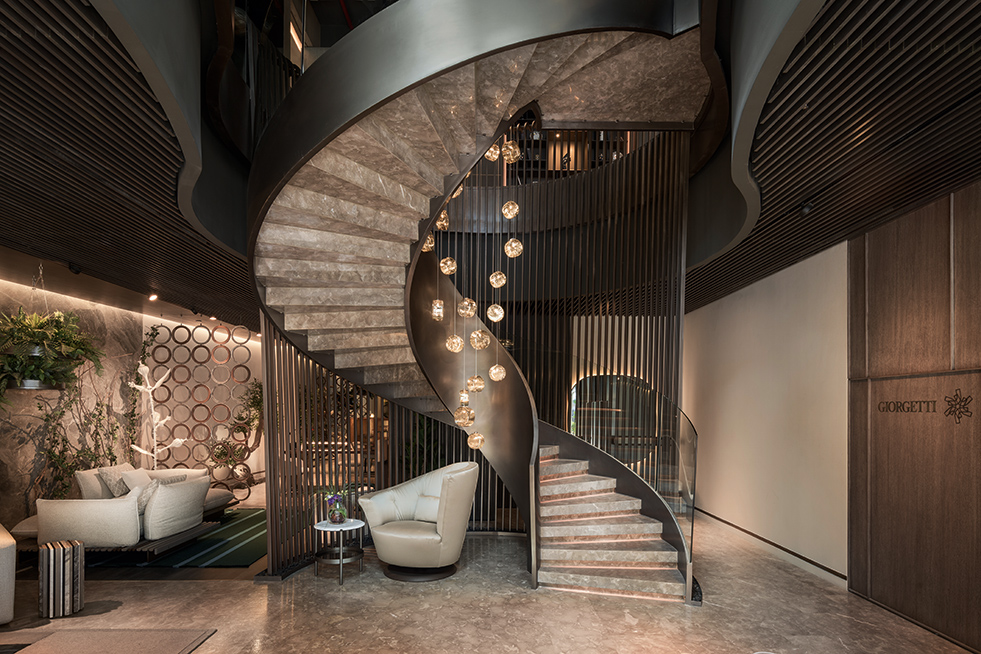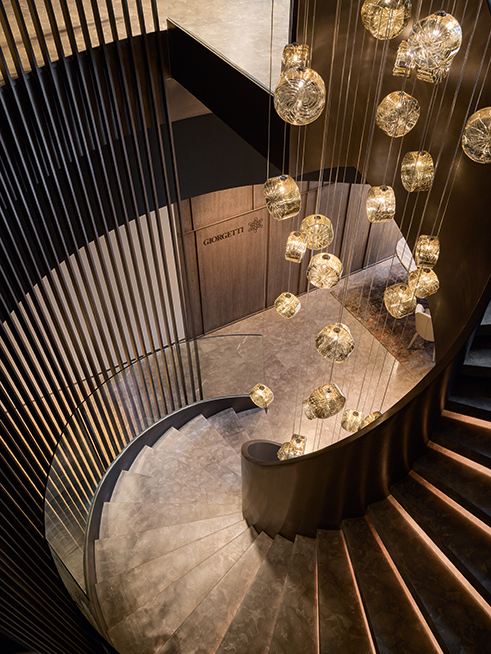HOTSPOT | Around the Persian Gulf. The El Dorado of today
Experts in foreign markets call it ‘El Dorado’. Extending from the coast of North Africa, the MENA region arrives as far as the countries of the Middle East. Arab consumers are some of the most fascinated by the legendary style of Italy, by the nation’s fine design and architecture. Younger demographics, greater purchasing power and notable investments in construction promise a dynamic growing market. Giorgetti has been there since the 1980s, well ahead of the curve.
By Roberta Busnelli
There are many good reasons to consider the MENA region interesting, going beyond the luxury goods market, which has seen impressive growth since the 1990s, especially in the United Arab Emirates. The countries of the Middle East and North Africa are strategic because they’re geographically close yet heterogeneous: some are resource-rich while others are based on labour. And they’re hungry for infrastructure and machinery, which are expected to be the main exported products for 2024 as well. Jewellery, cut precious stones and furniture are further down the list, but they help expand the value of exports in this area: selling crude oil and natural gas, MENA nations have been able to ensure the availability of resources and some of the most robust spending power in the world.
Anyone who exports to the area has won the bet. Since 2014, the value of Italian exports has consistently hovered around €30 billion, with the UAE as the top spender, making up 16.5% of the region’s purchases of Made-in-Italy goods. Next on the list, coming in over 10%, are Egypt, Saudi Arabia and Israel. After the slowdown caused by the Covid-19 pandemic, in the first seven months of 2021, Italian exports to the MENA region took off once again, growing 20.6% to €16.6 billion. The total exchange skyrocketed to €36 billion, a jump of 36%. In late 2022, the value of exports pre-Covid, about €29 billion in 2019, was reached and surpassed thanks in part to Expo 2020 Dubai and Dubai Design Week. In 2022, the FIFA World Cup in Qatar further boosted trade and business for the companies drawn to this region.
Though Giorgetti officially established a presence in this market in the early 1980s, its ties to the region go back even further. The company archives contain drawings (which are more like hand-painted small-scale works of art) from the 1940s and 1950s with furniture destined for the royal families of the Persian Gulf. In 2018, a direct branch was opened in Dubai. That’s precisely where we speak with Ruggero Ottogalli, the General Manager of Giorgetti Middle East & Africa, to better understand the promise and potential of this area. ‘In terms of global furniture revenue, the MENA region represents circa 3-3.5%. For Giorgetti, the region reaches about 6-7%, so it’s a presence that, in terms of percentages, is higher than average.’
Within the Middle East, the Persian Gulf States surely make up the lion’s share. The UAE is a very enticing market for Italian companies, considering that the domestic demand for furniture is almost entirely fulfilled by imported products. It’s a constantly expanding market. The FederlegnoArredo Research Centre places the UAE as the tenth export market for Italian furniture and interior accessories. The local production of furniture, moreover, is relatively minimal and the market is wide open to the importation of products from abroad, in the mid-high range, in which Italy is the leader, making up more than a third of imports. In addition to being the main destination for our exports in the MENA region, the UAE has become a strategic launch pad for expansion into the vast markets of Asia and Africa. ‘If we consider the Middle East as a whole, from the Persian Gulf to the Levant, we’re talking about a consumer pool of about 60 million people’, explained Ottogalli. ‘That’s the equivalent of Italy, but with much greater spending power per capita, reaching its highest peaks in the UAE, Saudi Arabia and Qatar.’
After opening the Dubai branch, by the end of 2024, the Giorgetti Group has planned nine new openings with two flagship shops, in Dubai and Riyadh. ‘To create the store in Dubai, we called two large firms, Richard Meier and Dante O. Benini’, Ottogalli recounted. ‘The plan includes the construction of an independent 800 m2 building, a villa in a central position within the coastal Jumeirah area, which has high visibility and is easy to reach. It’s the most famous district of the city, where all the luxury home furnishing brands are concentrated.’ For Giorgetti, the market of the UAE is a point of reference for the entire region, as is demonstrated by this significant, more-than-commercial investment. ‘The idea of creating an architecturally important building is also an ode to the city’, continued Ottogalli. ‘It’s artistic-cultural heritage which Giorgetti wants to leave as patrimony for the community. The expectations of this opening are surely high, as is the growth curve of the UAE and Dubai in particular. Today, after different transformations which were the fruit of well-thought-out, rather genius political strategies, the city has risen to the status of a luxury destination. It’s the Monte Carlo of the Middle East, the equivalent of the Italian or French Riviera in the 1960s, with its dolce vita attractions, enticing mainly to expats, the cosmopolitan world-travellers who want to enjoy their time and, if possible, their entire life. ‘When you talk about the UAE, like when you talk about the entire Middle East in general, the tendency is to confuse and simplify’, explained Ottogalli. ‘But in reality, there are deep differences between one country and the next. Dubai, the only emirate without oil, wanted to build an entirely different reality than that of its rich cousin Abu Dhabi. To compete and excel, Dubai has gone from a regional trade hub to a residential one for everyone who previously just conducted business here and who now are moving there because Dubai offers security, quick approval of businesses, a high quality of life, and now even a cultural life that’s on par with places like New York, Miami or Beijing.’ In addition to the Emirate of Dubai, in 2024 Giorgetti will also focus on Riyadh, the capital of the Kingdom of Saudi Arabia, opening a flagship 400 m2 space in the King Abdullah Financial District, a pre-existing area but new to the furniture industry. ‘Giorgetti already has an important space in Saudi Arabia, in Jeddah’, Ottogalli clarified. ‘Opening in Riyadh will guarantee a more direct presence for the brand, and thus we surely will see greater growth.’ Prince Mohammed bin Salman is driving the radical change that Saudi Arabia is currently undergoing. He has ushered in a wave of cultural and commercial liberalisation which was unthinkable just a few years ago, by way of soft power diplomacy which now is also focused on international tourism, so much so that the first travel agencies have begun to pop up in Saudi Arabia, promoting itineraries for true explorers. The royal family’s vision for the future includes strategic differentiation which will provide new business opportunities, including those for younger generations, and attract outside investment which previously was precluded. For both Dubai and Riyadh, what’s certain is that the policies adopted are consistently aimed at modernisation and looking to the future.
Giorgetti is on the move also in North Africa, more precisely in Cairo, where the company has recently opened a 300 m2 flagship store located on the street level of a newly built outdoor shopping centre, Park St. The complex offers different types of consumer experiences—luxury boutiques, gourmet restaurants, spas—and it’s also home to prestigious offices. ‘The location is similar to the Financial District of Riyadh, but Cairo is a much more complex city than Dubai or Riyadh’, Ottogalli stressed. ‘It’s sprawling, enormous, chaotic and particularly hard to get around. Egypt, whose population is immense, with over 100 million residents, but whose per-capita spending power is surely less than the UAE and Saudi Arabia, is always an unknown. A lot depends on the policies, regulations and bureaucracy. And yet, even here we expect growth. The city isn’t lacking investments in luxury projects within which Giorgetti products are valued and may indeed be a natural fit. This is why it’s essential to have our own flagship space thoroughly representing the philosophy and complexity of the brand, helping to raise awareness about the Giorgetti lifestyle.’
The traits shared by such different and evolving places—Dubai, Riyadh and Cairo—are few, but they exist. Here, Giorgetti plays its trump cards: reliability, openness to collaboration and the customisation of its products (which are materially complex and made by the detail-obsessed), timeless fine design, products which are heirlooms to pass down to future generations, the guarantee of being 100% Made in Italy, and the ability to combine artisan traditions with advanced technology. Quality and beauty.
Giorgetti goes where clients live and work, where they invest in themselves, their families and the spaces they work in. They may be bold choices and courageous investments at times. The kinds that are only for visionary leaders who have the virtue of patience.




